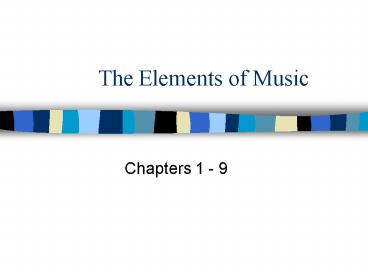The Elements of Music - PowerPoint PPT Presentation
1 / 23
Title:
The Elements of Music
Description:
... music through time; the pattern of durations of notes and ... the vertical aspect of music. Chord: a combination of three or more notes sounded simultaneously ... – PowerPoint PPT presentation
Number of Views:177
Avg rating:3.0/5.0
Title: The Elements of Music
1
The Elements of Music
- Chapters 1 - 9
2
Sound Pitch, Dynamics, and Tone Color
- Pitch- The high or low quality of sound
- Dynamics- The loud or soft quality of music
- Tone color- Also known as timbre, refers to the
unique quality of sound
3
Dynamics
- Forte--f,ff,fff-loud
- Piano--p,pp,ppp-very soft
- Mezzo---mf,mp--medium
- Crescendo--gradually louder
- Decrescendo,diminuendo--gradually softer
4
Voices
- Womens Voices
- Soprano
- Mezzo-soprano
- Alto
- Mens Voices
- Tenor
- Baritone
- Bass
5
Orchestral Instruments Stringspictures on p.
13-14
- Violin- highest pitched of string family
- Viola- medium pitched, takes role of supporting
actor - Cello- larger and lower pitched than viola, held
between knees - Bass- largest and lowest pitched of string
family, played while standing - Harp-47 strings and 7 foot pedals
6
Orchestral Instruments Woodwindspictures on p.
17-19
- Piccolo- highest pitched
- Flute- blown across tone hole
- Oboe- highest pitched of double reeds
7
Orchestral Instruments Woodwinds
- English horn- low oboe sound
- Clarinet- single reed
- Bassoon- lowest pitched of the double reed
instruments, aka clown of the orchestra.
Produces deep, nasal tone - Saxophone- made of brass, single reed
8
Orchestral Instruments Brasspictured on page 21
- Trumpet- highest pitched of the brass family
- French horn-not as bright as a trumpet, consists
of coiled tubing and is often used for hunting
calls - Trombone- incorporates a movable slide to change
pitches - Tuba- the lowest pitched of the brass instruments
9
Orchestral Instruments percussionpictured on
pp. 22-23
- Pitched percussion instruments
- Timpani large kettle drums
- Glockenspiel metal bars hit struck with mallets
- Xylophone wooden bars struck with mallets,
producing a dry brittle sound - Celesta small upright piano that sounds like a
glockenspiel - Chimes a set of metal tubes hung from a frame
which are struck by a hammer
10
Orchestral Instruments Percussionpictured on
pp. 23-24
- Unpitched percussion instruments
- Bass drum
- Snare drum
- Cymbals
- Gong
- Triangle
- Tambourine
11
Orchestral Instruments KeyboardsPictured on pp.
26-27
- Piano keys activate hammers that hit strings
- Harpsichord keys activate plectra which pluck
the strings - Pipe organ keys control valves that channel air
through various pipes
12
RhythmThe flow of music through time the
pattern of durations of notes and silences in
music
- Beat - the pulse of music
- Meter- the grouping of beats
- Tempo - the speed of the beat (pg. 34)
- Accent - a pitch that is played more loudly, held
longer or is higher in pitch than the nearby
notes - Syncopation- When an accented note comes where we
would normally not expect it
13
Tempo Markings
14
Tempo Markings
- Molto-much
- Non troppo-not too much (fast or slow)
- Accelerando- gradually faster
- Ritardando- gradually slower
15
Music Notation
- Notating pitch
- Staff the five lines and four spaces on which
music is written - Note an oval which represents a specific pitch
- Clef placed at the beginning of the staff, the
clef assigns pitch names to the lines and spaces
(pg. 36)
16
Music Notation (cont.)
- Notating Rhythm
- Durations the color of the note and the presence
of stems or flags and beams and dots affect the
duration of a note (pg. 37) - Restssymbols for pauses with specific durations
(pg. 36)
17
Music Notation (cont.)
- Notating meter
- Time signature placed next to the clef, the top
number of the time signature indicates the
grouping of beats and the bottom number indicates
what kind of note will receive one beat.
18
MelodyA succession of pitches which add up to
a recognizable whole
- Intervals the distance between two pitches
- Sequence the repetition of a melodic pattern at
a higher or lower pitch - Cadence a resting spot
19
Harmonythe vertical aspect of music
- Chord a combination of three or more notes
sounded simultaneously - Consonance harmony that is stable and restful to
the ear - Dissonancetense and unstable harmony that
demands onward motion to stable harmony
(resolution)
20
Key - Tonalitythe homing instinct of music
- Major scale a succession of eight pitches
arranged from low to high, based on the intervals
of the white keys of a piano (pg. 46) - Minor scale a succession of eight pitches
arranged from low to high, based on a specific
pattern of whole and half steps which results in
a dark quality of melody and harmony
21
Key-Tonality (cont.)
- Chromatic scale a series of 12 pitches based on
the black and white keys of the piano - Modulation the shifting from one key to another
22
Texturelayers of sound
- Monophonic a single unaccompanied melody line
- Polyphonic two or more independent melody lines
happening simultaneously - Homophonic melody plus accompaniment
23
Musical Formthe shape, structure and
organization of music
- Binary form AB
- Ternary form ABA
- Rondo ABACAD
- Theme and VariationsA A A A A
- Ballad form AABA
- Strophicstanzas or verses
- Call and response































